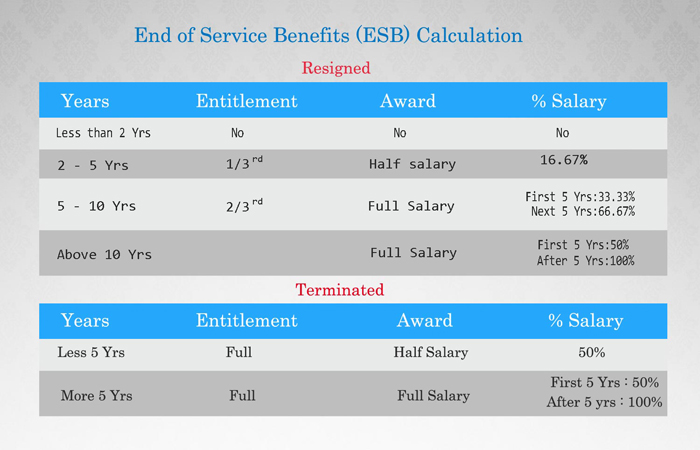End of Service Benefits (ESB) Calculation Saudi Arabia
- Article
- Comment
Introduction
End of Service Benefits (ESB) Calculation Saudi Arabia. Saudi ESB calculation has some formula to calculate it. ESB calculator is available from the Saudi Govt website itself. There you can use and calculate the ESB for an employee. From their formula, I just created an image for your better understanding. I hope this helps better to understand it.
From their website I have understand their formula for the calculation, which I am going to write below in it. If you are looking to create ESB for your software you can change it to any language and apply it to be there.
Let me start with PHP and also I will provide it on JavaScript as well.
PHP ESB Calculation
Let’s write the program for ESB. You have to provide the following parameters to calculate ESB for an employee.
<?php
$status_text = 'Terminated';
$years = 6;
$months = 4;
$days = 28;
$yearsonly = $years + ($months/12) + ($days/365);
$last_paid_salary = 5000;
if($status_text == 'Resigned'){
if ($yearsonly < 2) {
$result = 'Not eligible end of service benefits';
}elseif ($yearsonly <= 5) {
$result = (1 / 6) * $last_paid_salary * $yearsonly;
}elseif ($yearsonly <= 10) {
$result = ((1 / 3) * $last_paid_salary * 5) + ((2 / 3) * $last_paid_salary * ($yearsonly - 5));
} else {
$result = (0.5 * $last_paid_salary * 5) + ($last_paid_salary * ($yearsonly - 5));
}
}elseif($status_text == 'Terminated' || $status_text == 'Decesed'){
$firstPeriod = $secondPeriod = 0; // set periods
if ($yearsonly > 5) {
$firstPeriod = 5;
$secondPeriod = $yearsonly - 5;
} else {
$firstPeriod = $yearsonly;
}
$result = ($firstPeriod * $last_paid_salary * 0.5) + ($secondPeriod * $last_paid_salary); // calculate
}
echo $result; ?>
That’s it for the PHP function, Let’s write the JS program to calculate it.
JavaScript
Once you understand the concept, you can even write it in Javascript.
var status_text = 'Terminated';
var years = 6;
var months = 4;
var days = 28;
var yearsonly = years + (months/12) + (days/365);
var salary = 5000;
if(status_text == 'Resigned'){
if (yearsonly < 2) {
result = 'Not eligible end of service benefits';
}elseif (yearsonly <= 5) {
result = (1 / 6) * salary * yearsonly;
}elseif (yearsonly <= 10) {
result = ((1 / 3) * salary * 5) + ((2 / 3) * salary * (yearsonly - 5));
} else {
result = (0.5 * salary * 5) + (salary * (yearsonly - 5));
}
}elseif(status_text == 'Terminated' || status_text == 'Decesed'){
firstPeriod = secondPeriod = 0; // set periods
if (yearsonly > 5) {
firstPeriod = 5;
secondPeriod = yearsonly - 5;
} else {
firstPeriod = yearsonly;
}
result = (firstPeriod * salary * 0.5) + (secondPeriod * salary); // calculate
}
alert( result);
That’s enough I guess, if you have any suggestion, or clarification, or any further improvement, please comment on next tab, I will respond you as early as possible.



